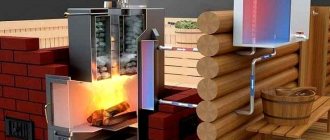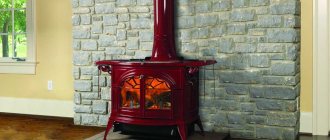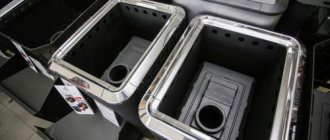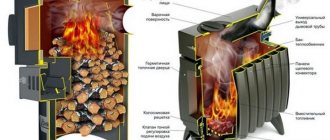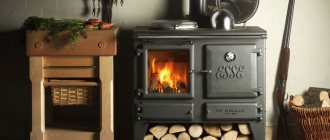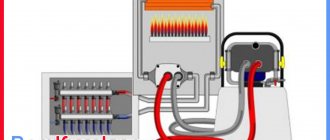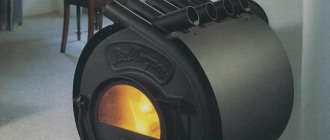What is furnace efficiency?
Efficiency – efficiency factor.
In physics, this term refers to the ratio of the real energy of the heat source (furnace) to the maximum energy indicator of the burned fuel. This is exactly the indicator that is indicated in the technical data sheet of the finished heating device. But it is important to understand that the figure indicated there will not correspond to the real one for several reasons. Collapse Contents:
- What affects efficiency?
- Ways to increase efficiency
- Installation of a steel pipe in the ash pit
- Install a steel pipe into the chimney
- Additional heat extraction from the stove
- Conclusion
Of course, a lot depends on the design of the heating system (this will be discussed in more detail in the next chapter). But there are also external factors:
- The quality of the fuel used is of great importance. The efficiency of a wood-burning stove will drop by 3 times if it is heated with raw material.
- Efficiency depends on the completeness of fuel combustion; this is affected not only by its quality, but also by air humidity, room temperature, and atmospheric pressure.
- Operating mode. If a person constantly keeps the firebox door open, one can only dream of high efficiency.
It becomes obvious that the efficiency factor is not a strictly fixed indicator. It can be reduced if the stove is used incorrectly, or the design can be improved by significantly increasing the efficiency parameter.
Features of a metal furnace
A metal stove takes up much less space in the house, but its installation requires its own characteristics and nuances. For such stoves you need to equip a special place.
Furnaces are made of durable cast iron or specialized profiled steel. The wall thickness starts from 2 mm and can reach 8 mm. Typically, the body of such furnaces has several layers - steel walls, insulating material, and a convector casing. With this design of the furnace equipment housing, residents are reliably protected from burns and thermal shock, and the risk of fire will be minimal.
Advantages of metal furnaces:
- Such stoves have a more beautiful design than, for example, brick ones and an aesthetic appearance, thanks to which they not only heat the room, but also serve as interior decoration.
- The service life of such furnaces. The equipment does not need to be moved or altered over time, like a brick oven.
- Quite inexpensive cost.
- Metal stoves quickly heat up and begin to give off heat, thereby creating a comfortable temperature in the room.
What affects efficiency?
Whatever the design of a wood-burning stove, the heat transferred to it will never be equal to what is obtained in its very “heart”, where the fuel burns. The reason is that part of the energy escapes through leaking dampers, foundations, and vents. In addition, the efficiency is affected by the design features of the furnaces:
- Wood stove base material. For example, cast iron structures retain heat for a long time, increasing efficiency. The efficiency of a brick kiln is greater, but it is difficult to maintain it at a consistently high level. Furnaces made of alloy steel have low efficiency, so they are often used in combination with fireclay.
- Height, cross-section of the smoke exhaust pipe. They determine the draft of a wood stove. Moreover, a decrease in efficiency will occur with both weak and excess thrust.
- Type of firebox. Open fireplaces are the least profitable option in terms of efficiency, since it is difficult to raise the indicator above 25%. By covering the fire (for example, with refractory glass) with similar parameters of a stove with an open firebox, the efficiency increases by 2-3 times.
- A stove with high efficiency will be obtained if there is afterburning of flue gases, a heat-intensive lining (talcomagnesite is best suited), and the connection of 2 or more water heating circuits.
The combustion device is also important - long-lasting, alternating or minimal. Increased efficiency is achieved in long-burning designs (which can be heated for more than 5 hours). If you are allowed to light a wood stove for 2-3 hours, then you should not expect high rates of room heating while saving fuel.
Types of homemade long-burning stoves
For heating small rooms, brick or metal stoves (potbelly stoves) can be used, capable of operating on both solid and liquid fuels.
Long-burning brick stoves are rarely built, since not everyone is able to lay them out with their own hands, taking into account the special requirements for the material and design of the chimney.
After all, an incorrectly made chimney pipe will result in continuous problems with insufficient draft and smoke in the room. In addition, purchasing fireclay bricks and the same powder for mortar will require a lot of money. And the brick oven itself takes up a lot of space, which is completely unacceptable for premises such as a garage, small country house or greenhouse.
Metal stoves, called potbelly stoves, can use free fuel in the form of waste oil, which does not require further disposal and brings tangible benefits.
Ways to increase efficiency
The designs and diagrams of finished furnaces do not provide for modes with variable efficiency. It all depends on proper operation, as well as the ability to independently upgrade the design. There are three simple ways to increase the efficiency of wood-burning stoves: installing a steel pipe in the ash pit, a metal rod in the chimney, or transferring heat from the tiles through the hood back into the room. Each of the methods for improving efficiency indicators is discussed below.
By the way, you can combine them with each other, then the efficiency of the stove will increase even more.
Installation of a steel pipe in the ash pit
If a wood stove is the only way to heat the room, then the air temperature in the room will continue to decrease for the first 40 minutes after ignition. Moreover, such a decrease will be more intense than after turning off the stove. The reason is the open vent, through which the rarefied warm air of the room is sucked into the smoke exhaust ducts.
As the stove heats up, air will flow through the view in the same quantity, but due to the sufficiently heated walls of the stove, heat transfer will begin to prevail. But is it possible to speed up this stage and thereby increase efficiency by 10-15%? You can - to do this, when laying it in the ash pit, install a steel pipe with a damper. As a result, when the view is opened, much less warm air is sucked in (it will be drawn not from the room, but from under the floor).

It is important to remember: the described method of increasing the efficiency of a wood-burning stove has a drawback - the chimney draws air from under the floor, so it will cool down quickly. Walking on a frozen floor is unpleasant. To fix this, you can attach a rubber extension with a diameter of 50 millimeters to the end of a steel pipe, then take it outside the wall of the house (then the ash pan will draw in street air).
Install a steel pipe into the chimney
A well-known fact: very hot air is exhausted through the chimney. Moreover, the longer the stove is heated, the less heat will be removed from the brickwork of the chimney and the hotter the evaporated smoke will be. Consequently, due to intensive operation of the furnace, the efficiency will decrease. People have come up with a trick that helps them use the heated air of the chimney to their advantage and prevent the efficiency from decreasing (such a modification is not found anywhere in finished projects).
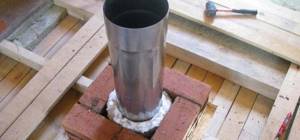
The essence of modernizing a wood stove is as follows:
- Take a round metal pipe with a diameter of 20-30 cm.
- The pipe is inserted into the chimney elbow at a slight angle.
- If the stove is large and has several smoke exhaust pipe bends, you can insert 3-4 metal pipes.
- The thermal conductivity properties of the metal ensure that heat is removed from the chimney. This heat does not go outside, but returns back into the room.
As a result, due to such simple modifications, a stove with high efficiency is obtained (the efficiency will increase by 15-20%). Warming up the room will be 2 times faster, and fuel consumption, on the contrary, will be reduced.
The only difficulty: modification of the stove with a homemade and simple heat exchanger can only be carried out at the time of laying the chimney. If you need to improve the efficiency of an already installed stove, the chimney will have to be disassembled and then reassembled.
Additional heat extraction from the stove
The heat emitted from the cooking surface of the stove can be redirected back into the room, thereby increasing the rate at which the house warms up. This process is called recycling. As a result, fuel consumption will decrease and efficiency will increase.
This simple upgrade is done as follows:
- A stainless steel hood is made above the stove surface (not close to avoid overheating).
- A quickly heated pipe (cross section 8-10 centimeters) is connected to the hood. For example, the material for it can be galvanized steel.
- The metal base of the tubular outlet must be at least 1 meter long. Further, it is allowed to be fastened with PVC pipes.
- The pipe should be stretched under the ceiling and brought to the coldest part of the room. It is recommended to supplement the design with small fans (a device with a power of 13 watts is sufficient).
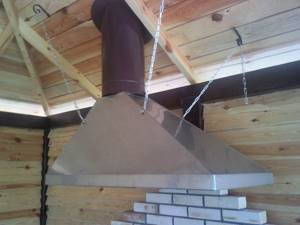
Hood on stove
There are no obvious disadvantages to the described method of increasing efficiency. The only inconvenience: when you turn off the stove, the installed tube will stop conducting heat and the indicators will return to their original values.
As an option: you can install filters (anti-grease and carbon) in the hood. Then the air from the stove will be cleared of the odors of food being cooked on the stove (you will get a simple version of an air conditioner, only without discharging warm air through the ventilation shaft outside the house).
How to increase efficiency
When designing or modifying a wood heating system at home, you should remember the basic rule - all elements must be proportionate, optimal and form a harmonious system. A huge firebox with little heat removal will reduce the level of efficiency, and vice versa, excessive heat removal will lead to operational problems.
The concept of “efficiency” means how much energy released during combustion is transferred in the form of heat to the heated room. This characteristic is influenced by a number of factors:
- Serviceability and cleanliness of the stove.
- Type of fuel burned.
- Fuel burning mode.
- Heat transfer method.
- Heat supply efficiency.
- Availability of additional fuel attachments.
Stove serviceability
A significant decrease in the efficiency of the furnace occurs when it is used incorrectly. There are different ways to burn wood, and if you burn it incorrectly, heat energy will be lost.
The soot deposited on the walls of the heat exchanger is an excellent heat insulator. To increase the efficiency of the furnace, you need to periodically, once every 2 months, clean all important parts from soot.
Attention! Soot in the furnace ducts and chimney can catch fire; do not allow deposits to accumulate in the heating system. Soot combustion is a common cause of fires!
The right fuel for your furnace
It is known that different types of wood produce different amounts of heat. You can increase the efficiency of your stove by using the right fuel. Hard types of wood - oak, acacia, ash - have a greater calorific value. In addition to density, an important characteristic is the moisture content of the firewood. Firewood with a moisture content of 15% is considered optimal, but such indicators can be achieved either by using a drying chamber, or by natural drying under a canopy for years in ventilated stacks.
Optimal combustion modes
The fuel combustion mode is also important. There are different ways to burn fuel efficiently:
- In the mode of pyrolysis decomposition and afterburning of gases.
- In optimal fast combustion mode with sufficient oxygen access.
- Layered combustion of fuel from top to bottom.
Pyrolysis mode
When burning fuel in pyrolysis mode, the efficiency of the furnace increases due to the long combustion time. The firebox is divided into two chambers - a smoldering combustion chamber, where in a slow mode the firewood decomposes into pyrolysis combustible gases, and a gas afterburning chamber. Technically it looks like this:
- Firewood is placed in the firebox; initially, combustion occurs in a hot mode with the supply of a large amount of air. This stage is necessary to create a fire cushion on the wood, as well as to warm up the chimney and the secondary afterburning chamber.
- The firebox door closes. The air supply is set to a minimum - so that there is enough for smoldering. Firewood decomposes into smoky pyrolysis gases, which pass through a hot afterburning chamber.
- The second chamber has secondary air ducts. They are aimed at a catalyst - a massive red-hot ceramic or metal object. In some furnaces, the wall of the secondary chamber acts as a catalyst.
- Relatively cold pyrolysis gases, passing through the catalyst, are heated, mixed with air and burned.
This ensures complete combustion of the wood. The efficiency of pyrolysis combustion plants can reach 85 - 90%.
Disadvantages of this method of burning wood:
- Difficulty in realizing optimal combustion.
- Impossibility of altering existing fireboxes.
- Cold gases in the chimney turn into condensation, which floods the chimney.
Advantages of this combustion method:
- Duration of work on one tab. In Buleryan stoves, one bookmark is enough to burn for 5 - 8 hours.
- With the correct design of the firebox, the efficiency is high.
- Constancy of generated energy.
Forced combustion
The rapid combustion of firewood in a firebox with a sufficient amount of air will be optimal only if there is a large heat exchanger that can quickly store and retain a large amount of heat. In this case, it is ideal to use water as a coolant, and a large insulated tank as a heat accumulator.
To burn a large amount of fuel in an optimal manner, you will need an ash chamber and a grate. They can be organized in any existing firebox made of two metal plates or bricks. Installing an ash pan in a ready-made firebox will reduce the volume, but will add combustion efficiency.
How it works:
- A large amount of fuel is immediately placed into the combustion chamber, which will burn throughout the entire mass from the bottom up.
- After kindling, the main door closes, the ash pan door opens, and the combustion is regulated.
- The flame should be smooth, hot, without jerks of detonation or pops. The color of the flame is straw with red or blue streaks.
- In this express mode, combustion continues until coals are formed. The ash pan door is closed, the firebox operates in slow mode.
- An oven with a grate can be converted into a hearth by covering the grate with a sheet of metal.
- Brick channels or a massive bell-shaped structure can provide good heat removal. An incorrect ratio between a powerful firebox and a small heat exchanger will lead to a significant amount of heat being “blown out” onto the street.
- You cannot use this mode if there is poor draft - this will lead to smoke inside the room.
- Not every firebox can withstand the heat of burning dry wood. Plain red brick or thin metal can burn or crumble. If possible, use this mode in fireboxes lined with fireclay bricks.
Gradual combustion of fuel
Fast mode with layer-by-layer combustion of wood can be achieved using special air supply systems. This solution is implemented in Stropuva long-burning boilers, but simple fireboxes are quite suitable for conversion.
Conclusion
The methods for increasing efficiency described in the article are easy to use and suitable for any wood-burning stove. They increase the efficiency of the heating device by 10-25%. As a result, the room will warm up faster, heat will leave the room more slowly, and fuel consumption will be significantly reduced.
But it is important to remember: any modernization will be in vain if the rules for operating the stove are violated. For example, if you use damp firewood, do not clean the ash pit on time, and keep windows and doors constantly open, you will not achieve high efficiency.
